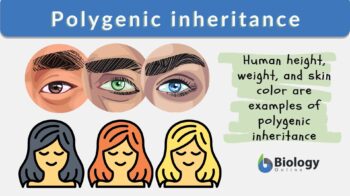
Polygenic inheritance
n., [‚päl·i‚jen·ik in′her·əd·əns]
Definition: the kind of inheritance in which the trait is produced from the cumulative effects of many genes
Table of Contents
Polygenic inheritance refers to the kind of inheritance in which the trait is produced from the cumulative effects of many genes in contrast to monogenic inheritance in which the trait results from the expression of one gene (or one gene pair). In monogenic inheritance, the expression may be predicted according to a phenotypic ratio that follows Mendelian inheritance. Polygenic inheritance is a non-Mendelian form since it is controlled by multiple genes at different loci on different chromosomes expressed together in the same trait.
For example, if one pair of genes controls color, and red is dominant to white, then when you cross two heterozygotes (Aa), red and white progeny will appear in the ratio of 3:1. However, if two pairs of genes control color and the dominant allele at both loci must be expressed to get red flowers, then crossing two heterozygotes (Aa Bb) will give you red and white flowers in a ratio of 9:7. This is a modification of the typical dihybrid Mendelian ratio of 9:3:3:1, in which three of the progeny groups all have the same phenotype.
Polygenic Inheritance Definition
What is polygenic inheritance? Polygenic inheritance, in simple terms, implies a character or phenotypic trait, which is regulated by more than one gene. In biology, it refers to the quantitative inheritance wherein two or more independent genes additively affect a single phenotypic trait. In a way, polygenic inheritance is a multiple factor inheritance or multiple gene inheritance, or multifactorial inheritance. Thus, polygenic inheritance is the phenotypic trait that is not a single gene trait but a cumulative expression of multiple genes.
It is important to note that polygenic inheritance is different from Mendelian Inheritance in terms of pattern and expression. In Mendelian Inheritance, each phenotypic trait is monogenic, meaning the expression of this trait is either expressed or masked based on it being ‘a dominant’ or ‘a recessive’ gene. In polygenic inheritance, the expression of the phenotypic trait does not display complete dominance wherein the phenotypic expression of a trait in an offspring is a mixture or additive of traits displayed in parents. In polygenic inheritance, there is an additive of the traits present in the parents. This type of inheritance pattern is known as the polygenic inheritance pattern.
What are polygenic inheritance examples? Human phenotypes or human physical traits such as hair color, height, skin color, blood pressure, intelligence, autism, and longevity are some of the examples of polygenic inheritance. Accordingly, traits, such as height or skin color, cannot be categorized as ‘tall’ or ‘short’ / ‘light’ or ‘dark’. These traits exhibit multiple and continuous variations of the phenotype.
Polygenic inheritance is controlled by two types of alleles or genes, namely:
- Contributing alleles: Alleles that contribute to continuous variation are referred to as contributing alleles
- Non-contributing alleles: Alleles that do not contribute to continuous variation are referred to as non-contributing alleles.
These alleles are sometimes referred to as effective and non-effective alleles, respectively.
Characteristics of Polygenic Inheritance
- A gene that employs a minor effect on a phenotype along with other genes is referred to as polygenes.
- The effect of an individual gene is too minor and often remains undetected
- Numerous genes exert an equal effect.
- Individually, each allele contributes to the result in a cumulative or additive manner
- The expression of one gene is not masked by the presence of the other genes, i.e., epistasis is not involved.
- The gene involved in polygenic inheritance is either contributing (active allele) or non-contributing (null allele); there are no genes as dominant or masked genes.
- There is a continuous variation of the phenotype of a trait in a polygenic inheritance
- The polygenic inheritance pattern is difficult to predict and it is highly complex.
- The statistical analysis of polygenic inheritance patterns can help to provide an estimate of population parameters. Most of the polygenic inheritance follow the normal distribution curve, wherein the majority of the people fall in the middle range of the curve.
- Polygenic inheritance is different from multiple alleles. In multiple alleles, on the same locus, three or more alleles are present an organism, e.g. human blood group system, i.e., the ABO system, is controlled by three alleles.
Analysis of Polygenic Traits
The pioneering work to understand the quantitative characters in terms of Mendelian genetics was carried out by Sir Ronald Aylmer (R.A.) Fisher in 1918. As we are aware that polygenic inheritance is a quantitative inheritance. Hence, it becomes important to understand the approaches or basis to differentiate between quantitative and qualitative inheritance.
- Polygenic traits are measured in terms of the characters like weight, length, width, height, duration, etc. Herein, the individuals cannot be classified into groups like color or shape.
- Population analysis for polygenic inheritance is carried out in terms of mean values obtained from several individuals. The variations are expressed in terms of variance or co-variance.
- Quantitative genetics or Biometrical genetics is the science that deals with the genetic interpretations of quantitative characters.
Difference between Polygenic traits and Oligogenic traits
Oligogenic traits are controlled by a limited number of genes whereas polygenic traits are controlled by a number of genes. The difference between polygenic trait and oligogenic traits are enlisted in the table below.
Table 1: Polygenic traits vs Oligogenic traits
| Polygenic traits | Oligogenic traits |
|---|---|
| Controlled by a number of genes | Controlled by few genes |
| The expression of an individual gene is minor and is usually undetectable. | The expression of individual genes is detectable. |
| Genes exhibit an additive effect | Genes exhibit a non-additive effect |
| Continuous variations | Discontinuous variations |
| Segregation of individuals into classes is not possible | Segregation of individuals into classes is possible |
| Environmental factors influence them | Not influenced by the environmental factors |
| Mean, variance and covariance are the statistical parameters used for the population evaluation | Ratios and frequencies are the statistical parameters used for the population evaluation |
Segmentation of Polygenic Variability
Variance is used to segregate the polygenic variation or variability present in a genetic population. The variation in polygenic inheritance is of three types. They are:
- Phenotypic
It is the observable variability and most often is the total variability which may include environmental as well as genotypic variations. It is expressed as the phenotypic variance. - Genotypic
This variability is inherited genetically and is unaffected by environmental factors. This is measured as genotypic variance and has dominant, additive, or epistatic components. This is the most commonly exploited variability utilized by plant breeders for carrying out hybridization.
Here, it is important to understand the meaning of additive variance. These are the variations that are produced due to the average effects of genes that are present on different loci. In simpler terms, in such variance, there is no dominant allele, i.e, the output of AA and aa would be an average effect of both dominant and recessive alleles resulting in intermediate expression. This is most widely found in self-pollinating crops wherein crossbreeding results in minimum cases of additive variance. - Environmental
These are the non-heritable variations that have occurred due to environmental factors and vary under different environmental conditions. This type of variance is completely uncontrolled and is measured in terms of error mean-variance.
Polygenic Inheritance Examples
Let’s take a look at the examples of polygenic inheritance.
1. Polygenic inheritance in humans
A. Skin color and pigmentation
The color of the skin is polygenic inheritance. It is controlled by around 60 loci. To understand the inheritance pattern of skin color let us consider an example of pair of three different alleles present at unlinked loci represented as A and a, B and b, C and c. The alleles responsible for dark color skin are represented by letters where capital letters represent those that are incompletely dominant alleles. Accordingly, the greater number of “capital letters” in the genetic pattern indicates dark skin color whereas the presence of a greater number of “small letters” represents the lighter color of the skin.
The progeny of the parents with genotype AABBCC and aabbcc will have intermediate color in the F1 generation, i.e. genotype would be AaBbCc. Further, in the F2 generation of two triple heterozygotes parents — AaBbCc x AaBbCc — will produce varying skin colors ranging from very dark to very light, the ratio of which would range in 1:6:15:20:15:6:1 (see Figure 1). The skin color of an individual is due to the presence of melanin in the skin. A dark skin color (with all dominant alleles, AABBCC) would have the highest amount of melanin in the skin. Conversely, a light skin color (aabbcc) would have the least or a negligible amount of melanin in the skin.
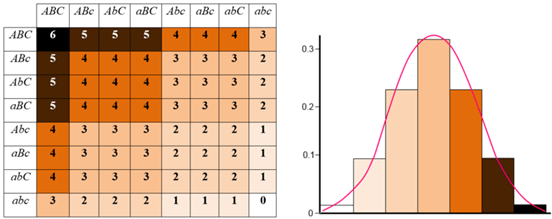
B. Human height
Human height is a polygenic trait that is controlled by three genes that have six alleles. So, a tall person would have all dominant alleles whereas a short person will have the most number of recessive alleles. Like all the polygenic inheritance patterns, human height inheritance also follows a normal distribution curve wherein the extreme ends of the curve represent either extremely short or tall people, while the middle portion of the curve represents the population with average height (see Figure 2).
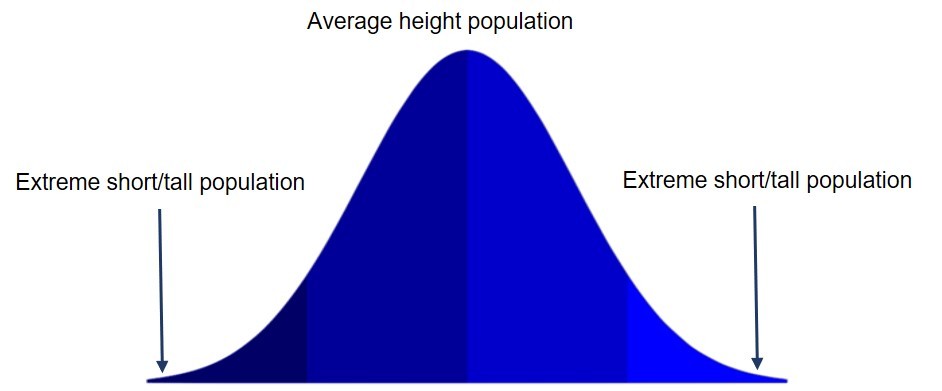
C. Polygenic inheritance of the human eye color
The eye color follows a polygenic inheritance pattern. In humans, 9 eye colors are recognized. Phenotypic expression of eye color is controlled by two major genes and 14 additional genes, which are linked to X chromosomes. Different combinations of these alleles result in a variety of eye colors. The eye color is due to the presence of melanin in the front portion of the iris.
Black and brown eye color has a high amount of melanin in comparison to the hazel or green eye color while the complete absence of the melanin results in blue eye color. Dominant allele (BBGG) contributes to the melanin synthesis in the iris that results in black eye color while the combination of all recessive alleles (bbgg) results in blue eye color. The rest of all the eye colors are the combination of these dominant and recessive alleles. See below:
- BBGG results in Black eyes
- BBGg or BbGG results in Dark Brown eyes
- BbGg or BBgg or bbGG results in Light Brown eyes
- Bbgg or bbGg results in Green eyes
- Bbgg results in Blue eyes
2. Polygenic inheritance in plants
The shape and color of the flower, stem, pollen, size of a seed, yield, oil content, time to mature or reach flowering, etc. are some of the polygenic traits in plants.
A. Kernel color of the wheat
The kernel color of the wheat is controlled by the expression of the three independently assorted pairs of alleles. The dark red wheat kernel is an expression of all dominant alleles, i.e., AABBCC, while the white kernel color is an expression of the recessive allele, i.e., aabbcc. Consequently, when the AABBCC wheat is crossed with aabbcc, the F1 generation will have an intermediate red color kernel with AaBbCc. Further, in the F2 generation, during crossbreeding, there would be 1 white kernel plant while 63 red kernel plants with varying shades would be produced.
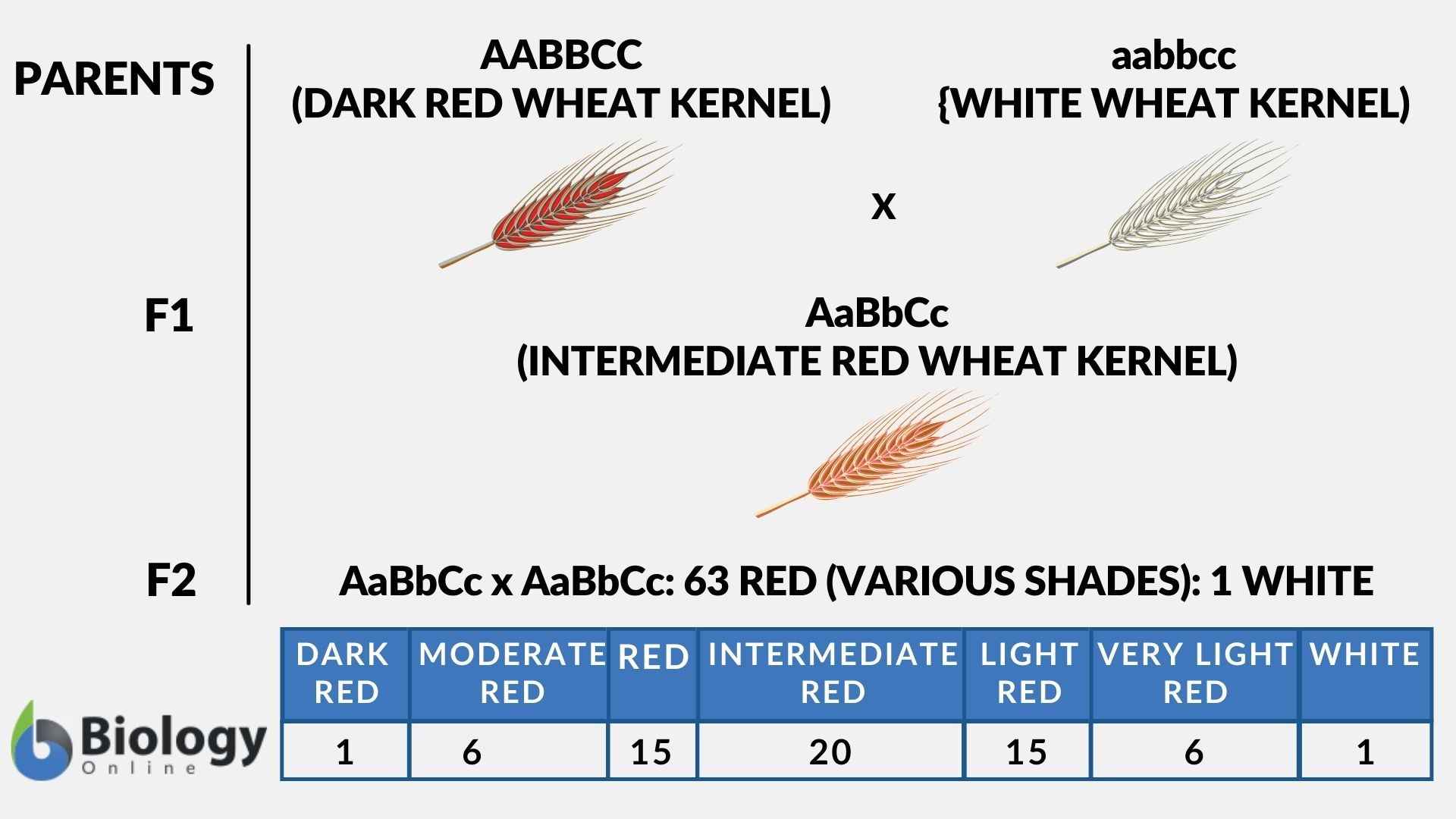
B. Length of the corolla in tobacco
The length of the corolla in the tobacco plant is an expression of the 5 genes. The variation in the length of the corolla in tobacco is due to polygenic inheritance.
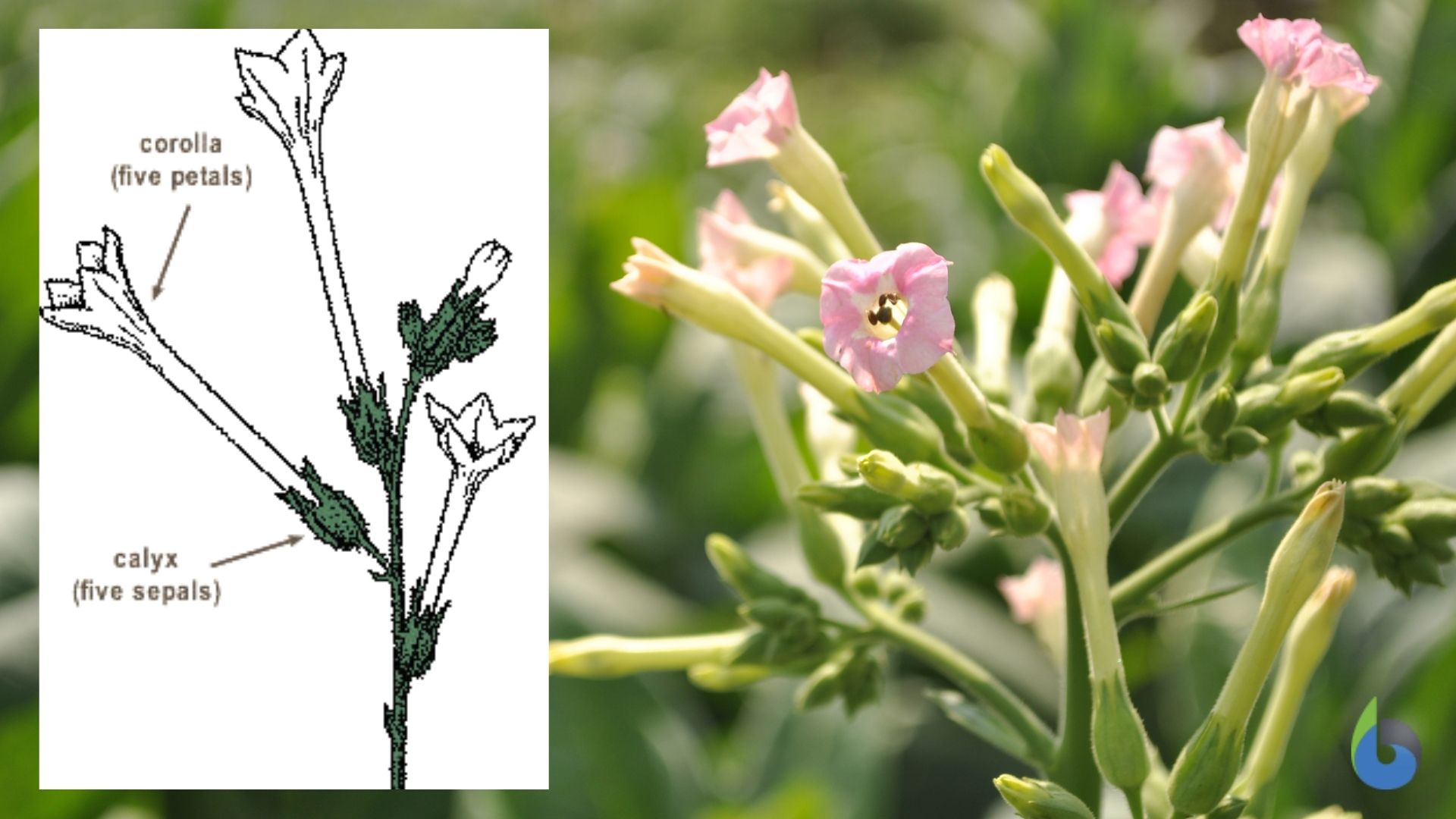
Effect of Environment on Polygenic Inheritance
Polygenes are highly influenced by environmental factors. Basically, the genotype of an individual sets the range of the quantitative trait while the phenotype of the trait is eventually an outcome of the environmental factors. Different environmental conditions regulate the gene function resulting in varying gene function. Accordingly, under different environmental conditions, the gene function may switch OFF or switch ON. This variation in the phenotypic expression of the same genotype under different environmental conditions is known as the ‘norm of reaction’. Depending on the genotype involved, the norm of reaction can be classified as:
- Narrow norm of reaction, e.g., human height
- Broad norm of reaction
Nature and nurture both affect phenotypic expression. Intelligence, depression, height, skin color, schizophrenia are some of the human characters that are affected by the environment.
A medical example of the effect of environmental factors on polygenic inheritance is the hereditary disorder phenylketonuria. The individual with homozygous alleles for the PKU disease lacks the enzyme that breaks down the amino acid, phenylalanine. In such patients, phenylalanine is retained in the body resulting in toxic buildup. This toxic build-up eventually causes intellectual disability, seizures, and mood disorders. The treatment for this disorder is very simple, by keeping the patients on a specific diet. The dietary change helps to reduce or even alleviate the phenylketonuria disorder. Due to this, many countries screen newborns for their genetic constitution to identify phenylketonuria disorder.
Why is Polygenic Inheritance Important?
Polygenes are responsible for the population variance and have evolutionary significance. These polygenic variations or changes (polygenesis) are responsible for the evolution of species. This is also known as the theory of polygeny for evolution. The variations are according to the specific requirement and needs of the individual or species. These are essentially responsible for adaptive changes. The polygenes are majorly applied or utilized by the plant breeders. The genetic variability is stored in the form of polygenic complexes. Segregation and recombination of polygenic genes after interbreeding results in the release of hidden variability in a species.
References
- Carter C. O. (1969). Polygenic inheritance and common diseases. Lancet (London, England), 1(7608), 1252–1256. https://doi.org/10.1016/s0140-6736(69)92130-8
- Carter C. O. (1977). Principles of polygenic inheritance. Birth defects original article series, 13(3A), 69–74.
- Khoury, M. J., Janssens, A. C., & Ransohoff, D. F. (2013). How can polygenic inheritance be used in population screening for common diseases?. Genetics in medicine : official journal of the American College of Medical Genetics, 15(6), 437–443. https://doi.org/10.1038/gim.2012.182
- Lange K. (1997). An approximate model of polygenic inheritance. Genetics, 147(3), 1423–1430.
- Loh, P. R., Genovese, G., & McCarroll, S. A. (2020). Monogenic and polygenic inheritance become instruments for clonal selection. Nature, 584(7819), 136–141. https://doi.org/10.1038/s41586-020-2430-6
©BiologyOnline.com. Content provided and moderated by Biology Online Editors.



